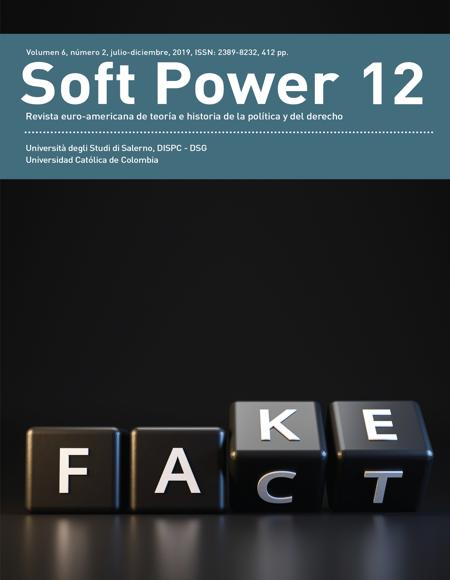Resumo
This article sustains that the so-called ‘post-truth’ phenomenon also depends on the characteristics of the new ‘hybrid’ communicative scenario. The thesis is that this new scenario is substantially different from that of the ‘party democracy’, protagonist of significant part of the twentieth century, and from that of the ‘audience democracy’, defined by Bernard Manin in the mid-nineties. The emergence of new media entails a series of consequences, including the fragmentation of the audience into a plurality of self-referential segments, politically polarized ‘bubbles’, devoid, at least potentially, of a common communicative sphere. Taking into account such developments, the article seeks to construct the ‘ideal type’ of a ‘bubble democracy’, marked by the mistrust of institutions, fragmentation of the audience, disintermediation, homophilic tendencies, and polarization.

Referências
Anagnostopoulos A. et al. (2016), Viral misinformation: the role of homophily and virality, Epj Special Topics, 355-356.
Bakshy E. –Messing S. –Adamic L.A. (2015), Exposure to Ideologically Diverse News and Opinion on Facebook, Science, 348, 1130-1132.
Bartlett J. (2018), The People Vs Tech. How the internet is killing democracy (and how we save it). London: Ebury Press.
Bessi A. et al. (2015a), Science vs. conspiracy: Collective narratives in the age of Misinformation, PLoS ONE, 10(2), retrived from: https://journals.plos.org/plosone/article?id=10.1371/journal.pone.0118093
Bessi A, et al. (2015b) Trend of Narratives in the Age of Misinformation. PLoS ONE 10(8). Retrived from: https://journals.plos.org/plosone/article?id=10.1371/journal.pone.0134641
Campbell J. (2018), Polarized. Making Sense of a Divided America. Princeton (N.Y), Princeton University Press.
Dalton J. & Weldon S., (2007), Partisanship and Party System Institutionalization, Party Politics, 2, 179-196.
Del Vicario M. et al. (2016), The Spreading of Misinformation Online, Proceedings of the National Academy of Sciences, 3, 554-559.
Del Vicario M. et al. (2017), Mapping Social Dynamics on Facebook: The Brexit Debate, Social Network, 50, 6-16.
Dick P. (1964), The Penultimate Truth. New York: Belmont Books.
Dillhaut T.R., Brooks C.A., Gulati S. (2015), Detecting and Visualizing Filter Bubbles in Google and Bing, Proceedings of the Thirty-Third Annual Acm Conference: Extended Abstracts on Human Factors in Computing Systems. New York, 1851-1856.
Hannak A. et al. (2013), Measuring Personalization of Web Search, Proceedings of the Twenty-Second International Conference World Wide Web, New York, 527-528.
Iyengar S. & Westwood S.J. (2015), Fear and Loathing across Party Lines: New Evidence on Group Polarization, American Journal of Political Science, 59(3), 690-707.
Iyengar S., Sood G., Lelkes Y. (2012), Affect, Not Ideology: A Social Identity Perspective on Polarization, Public Opinion Quarterly, 76(3), 405–431.
Jay M. (2010), The Virtues of Mendacity: On Lying in Politics. Charlottesville: University of Virginia Press,.
Kirchheimer O. (1966), The transformation of the West European Party Systems, in J. La Palombara & M. Weiner (Eds.), Political Parties and Political Development (177-200). Princeton (N.Y): Princeton University Press.
Lorusso A.M. (2018), Postverità. Roma-Bari: Laterza.
Manin B. (1997), Principles of representative government. Cambridge: Cambridge University Press.
Mounk Y. (2018), The People vs. Democracy: Why Our Freedom is in Danger and How to Save It, Cambridge (Mass.): Harvard University Press.
Palano D. (2017), Populismo. Milano: Bibliografica.
Palano D. (2018), La maggioranza silenziosa. Chi vota la destra populista?, in C. Fumagalli & S. Puttini (Eds.), Destra (pp. 80-92), Milano: Fondazione Feltrinelli.
Palano D. (2019a), The «Democratic Recession» and the Crisis of Liberalism, in A. Colombo & P. Magri (Eds.), The End of a World. The Decline of the Liberal Order (pp.37-50). Milano: Ledi.
Palano D. (2019b), La fin du «public», la bubble democracy et la nouvelle polarisation, in C. Delsol & G. De Ligio (sous la direction de), La démocratie dans l’adversité. Enquête international (pp. 699-715), Paris: Cerf.
Palano D. (2019c), La democrazia alla fine del pubblico. Sfiducia, frammentazione, polarizzazione: verso una bubble democracy?, Governare la paura, 35-92.
Palano D., Bubble democracy. La fine del pubblico e la nuova polarizzazione, Brescia: Scholé.
Pariser E. (2011), The Filter Bubble: How the New Personalized Web Is Changing What We Read and How We Think. New York: Penguin Press.
Pew Reasearch Center (12 june 2014), Political Polarization in the American Publics, retrived from https://www.people-presso.org.
Pierskalla J.H. & Hollenbach F.M. (2012), Technology and Collective Action: The Effect of Coverage on Political Violence in Africa, American Political Science Review, 3, 207-224.
Prior M. (2017), Post-Broadcast Democracy. How Media Choice Increases Inequality in Political Involvement and Polarizes Elections, Cambridge: Cambridge University Press.
Schkade D., Sunstein C.R., Hastie R. (2007), What Happened on Deliberation Day?, California Law Review, 3, 915-940.
Sunstein C.R. (2002), The law of group polarization, The Journal of Political Philosophy, 2, 175-195.
Sunstein C.R. (2017), #republic. Divided democracy in the age of social media. Princeton (N.Y.): Princeton University Press.
Tarde G. (1901), L’opinion et la foule. Paris: Alcan.










